5 Fern-like Weeds
Have you found a fern-like weed growing in your yard or garden and trying to identify it? Here are several plants that have foliage similar to ferns.
Ferns are members of a division of vascular plants. They possess special tissues that are used to transport water and nutrients throughout the plant. Unlike the majority of plants that propagate via seeds, ferns reproduce via spores and they don’t produce flowers or seeds.
Although there are numerous species of ferns, they are often recognized by their complex and attractive leaves (generally called “fronds”). However, there are many other plants that have fern-like leaves, without being true ferns.
Below there is a list of weeds that have foliage similar to ferns.
Contents
1. Poison Hemlock (Conium Maculatum)
Poison hemlock (Conium maculatum) is a biennial weed in the family of Apiaceae. It is also commonly known as hemlock, deadly hemlock, or wild hemlock. All its parts are highly toxic to animals and humans.
It is native to Europe and North Africa and has been introduced as an ornamental plant to other parts of the world such as Australia, Asia, and America.
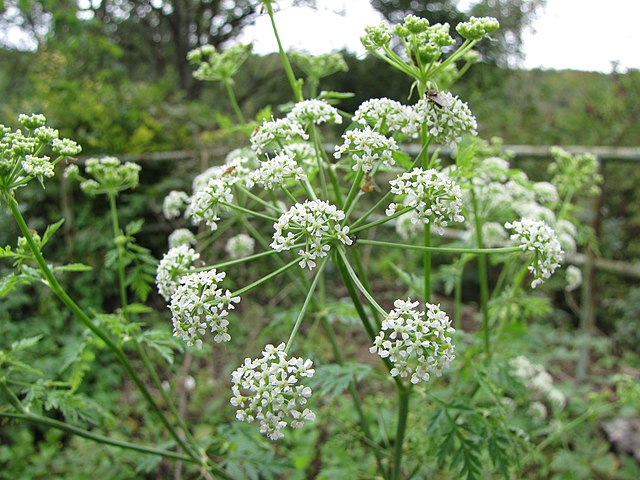
Conium maculatum is a versatile plant and can live in many soil types and environmental conditions. It also tends to spread quickly, becoming an invasive weed.
The hemlock plant does not produce flowers and seeds in its first year. It starts as a basal rosette of leaves that can easily be mistaken for the wild carrot plant (Daucus carota), cow parsley (Anthriscus sylvestris), or a fern species.
In the second year, hemlock is easier to identify because it produces long, spotted, hollow stalks that branch toward the end and produce umbrella-shaped clusters of white, tiny flowers.

Poison hemlock leaves are bright green, compound, hairless, fern-like, finely divided with toothed edges, and overall triangular. When crushed, they emit an unpleasant odor.
2. Sweet Cicely (Myrrhis Odorata)
Sweet cicely (Myrrhis odorata) is a biennial plant in the family Apiaceae. It is also generally known as cicely, myrrh, garden myrrh, or sweet chervil.
Myrrhis odorata is native to parts of Europe and was introduced to North America and other regions of the world as a garden herb. It has a long history of use as a medicinal plant and its roots, seeds, and leaves are edible.
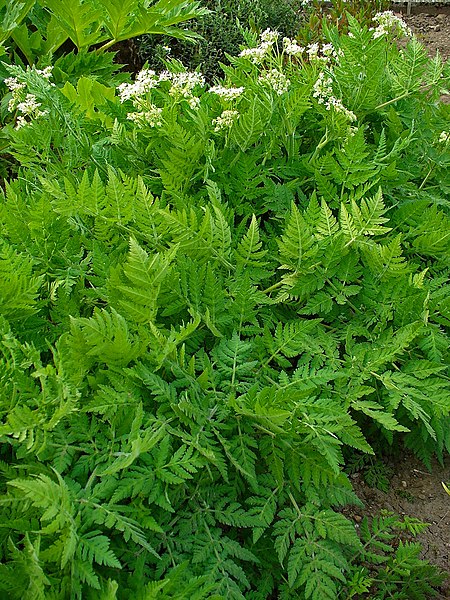
Cicely looks very similar to poison hemlock and may easily be mistaken for it. However, while cicely has edible parts, hemlock is highly poisonous.
The plant typically grows about 3.2 feet (1m) in height but in the right conditions can grow even taller.
It has beautiful green fern-like leaves which grow alternate on the stems, are compound, pinnately divided, and produce a powerful aniseed scent when crushed.
It produces umbrella-like creamy-white flowerheads.

Although occasionally the sweet cicely is cultivated in gardens as a herb, when it grows wild, it is often regarded as a weed.
3. Common Ragweed (Ambrosia Artemisiifolia)
Common ragweed (Ambrosia artemisiifolia) is a species of annual weed native to regions of the Americas and introduced to Europe and other continents through grain crops. It is also known as annual ragweed or low ragweed.
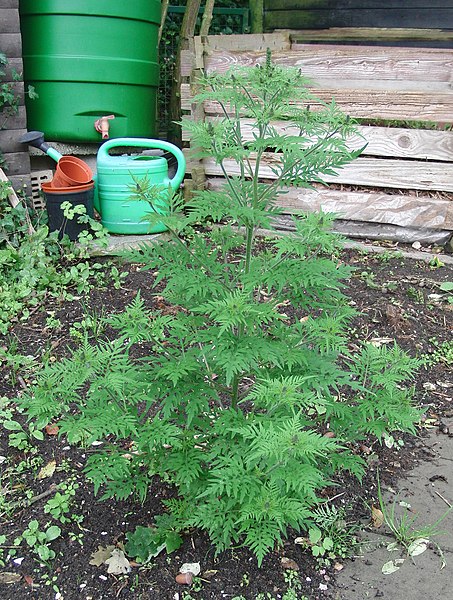
This plant is considered a noxious weed in many regions. Not only is it very adaptable and can multiply rapidly, but its pollen carried by the wind can cause various allergic reactions in susceptible individuals.
Common ragweed is frequently found growing in grain and sunflower crops, along roadsides and railroad tracks, in waste areas, and other abandoned places, but it can also occur in yards or gardens.
Ambrosia Artemisiifolia looks like a fern especially when the plant is young and the leaves grow as a basal rosette.
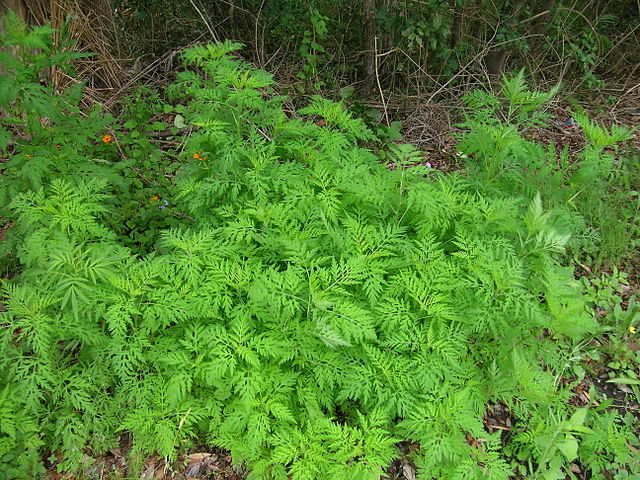
The leaves of common ragweed are deeply divided and composed of multiple leaflets that give them an aspect similar to ferns’ fronds. They initially have a yellow-green color and later get a yellow-brown tint as they mature. The surface of the leaf is slightly rough and presents hairs both on the upper and lower sides.
4. Cow Parsley (Anthriscus Sylvestris)
Cow parsley (Anthriscus sylvestris) is a biennial or short-lived perennial plant in the family Apiaceae. Some of its other familiar names include wild chervil or wild beaked parsley.
Anthriscus sylvestris is native to Eurasia and northwestern Africa and was widely naturalized in many other parts of the world.
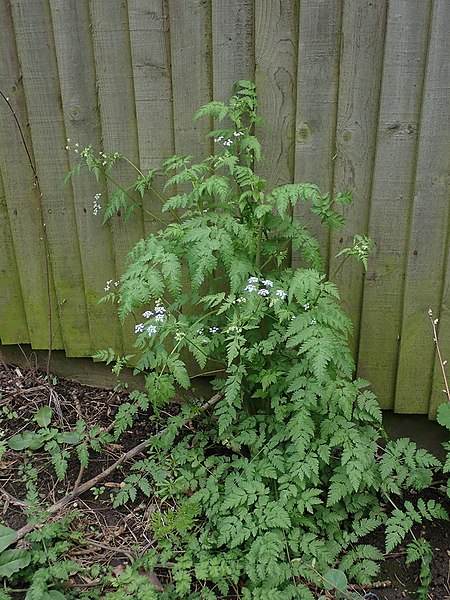
Although the plant’s aboveground parts are generally considered edible or mildly toxic by other sources, its foraging is not advised because it can easily be confused with other extremely poisonous plants like poison hemlock (Conium Maculatum), hemlock water-dropwort (Oenanthe crocata) and fool’s parsley (Aethusa cynapium).
Cow parsley can thrive in various environments and can be seen growing as a garden weed, or wildly along roadsides, in meadows, at the edges of woodlands, etc. It has a fast growth habit and an efficient way of spreading. That’s why it is considered an invasive weed in multiple countries.
Anthriscus sylvestris grows upright, usually not exceeding 5 feet (1.5m) in height. Its stems are green with flushes of purple, hollow, striped, and have tiny hairs on their surfaces.
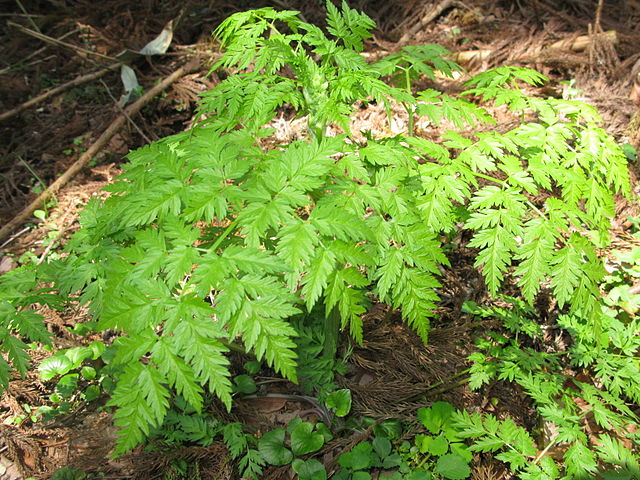
The foliage of this plant is similar to ferns. The leaves are green, triangular, compound, 2-3 pinnate, and have hairs on the underside.
Its flowers are tiny and grow as large, flat umbrellas.
5. Turnip-Rooted Chervil (Chaerophyllum Bulbosum)
Turnip-rooted chervil (Chaerophyllum bulbosum) is a species of biennial plant native to Europe and Asia. Other common names for it include the parsnip chervil, tuberous-rooted chervil, or bulbous chervil.
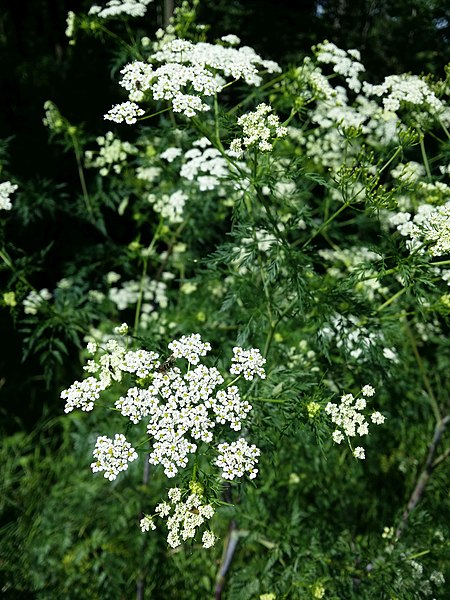
Chaerophyllum Bulbosum has been a popular garden vegetable in the past, but now it is only rarely cultivated and is found more often in the wild. Its tubers are regarded as edible, while the above-ground parts are considered potentially poisonous by various sources.
Turnip-rooted chervil is a moisture-loving plant and can grow in many soil types. It is seen growing wildly predominantly along river banks, where it forms crowded populations of plants.
Being a biennial plant, in the first year, it only grows as a rosette of leaves, which may resemble a fern. In the second year, it develops branched stalks on top of which produce umbrella-like inflorescences composed of numerous white, small flowers. The plant doesn’t usually exceed 4ft (1.2 m) in height.
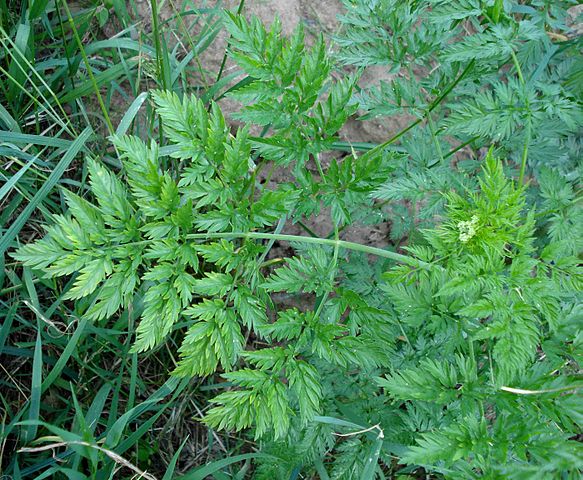
Its leaves are green, large, pinnately compound, alternate, and spirally arranged.
Final Word
These are a few weeds that develop foliage similar to that of ferns, although they are not true ferns.
Other species of plants that have compound pinnate leaves that may look like some species of ferns:
- Fringed bleeding heart (Dicentra eximia)
- Willdenow’s Spikemoss (Selaginella willdenowii)
- Leptinella scariosa
- Oshá (Ligusticum porteri)
- Common yarrow (Achillea millefolium)
- Pineappleweed (Matricaria discoidea)
- Wild carrot (Daucus carota)
You might also find interesting our article called “7 trees with fern-like leaves.”

